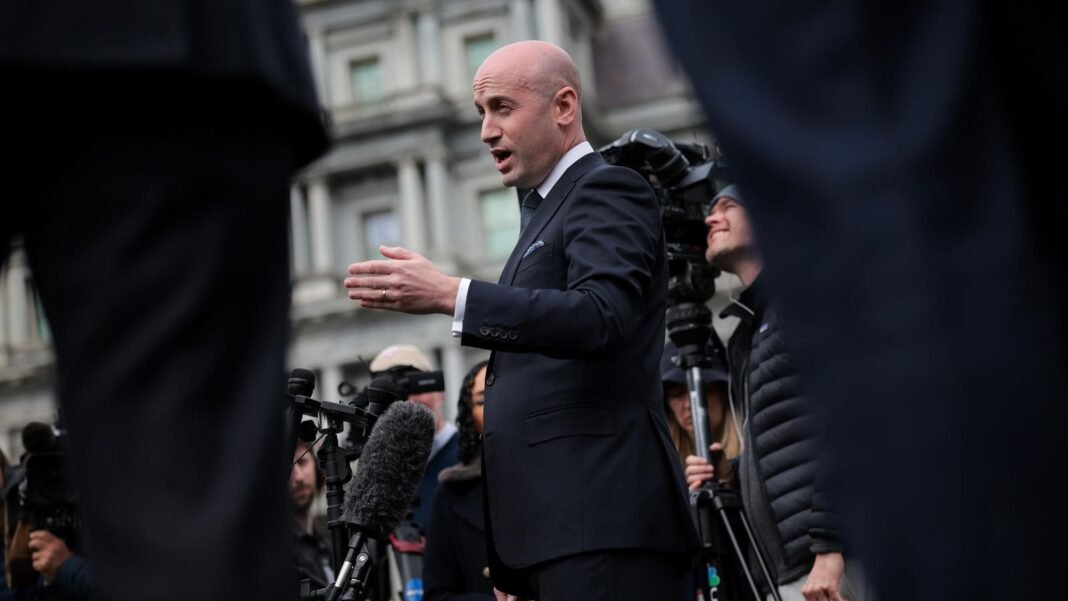Rising Immigration Enforcement and Its Effects on Local Communities
Intensified Arrest Mandate from Stephen Miller
Stephen Miller, a principal architect of the Trump administration’s immigration policies, summoned ICE’s senior field commanders in Washington, D.C.,urging them to escalate arrests well beyond individuals with criminal histories. In a May 2025 briefing, Miller sharply criticized ICE leadership for what he deemed insufficient enforcement efforts.
An ICE official recounted Miller’s demand for more aggressive tactics: “Why aren’t you conducting operations at places like Walmart or fast-food chains?” When questioned about focusing solely on criminals, Miller dismissed that strategy as ineffective and insisted on broader sweeps. This directive aimed to increase daily detentions from several hundred to thousands.
By early 2025, the administration set goals of at least 1,200 to 1,500 arrests per day after President trump expressed dissatisfaction with deportation rates. Subsequent statements revealed ambitions of reaching up to 3,000 daily apprehensions-an unprecedented scale that could result in over one million removals annually if maintained.
The Home Depot Operation: Spark for Protests and National Guard Activation
The June 6 raid at a Los Angeles-area Home Depot parking lot became symbolic of this intensified enforcement approach. Workers noticed unusual activity when agents clad in tactical gear arrived unexpectedly. As federal officers detained dozens-including many without criminal records-panic spread among nearby day laborers.
This event triggered immediate protests marked by confrontations between demonstrators and law enforcement officials.Authorities responded with tear gas and stun grenades amid rising tensions as crowds followed federal vehicles departing the scene while throwing objects defiantly.
In response to escalating unrest and threats against immigration personnel nationwide, President Trump authorized deployment of roughly 2,000 National Guard troops under 10 U.S.C. §12406, permitting such action “to execute those laws.” Although this fell short of invoking the Insurrection Act, California officials challenged its legality through lawsuits.
Navigating Legal Boundaries Around Military Support
The National Guard activation relied on 10 U.S.C. §12406, which allows governors or designated commanders to mobilize units for federal purposes including limited law enforcement support under specific conditions. Legal experts emphasize that this authority is narrower than powers granted by the Insurrection Act; it primarily focuses on protecting government personnel rather than broad policing roles.
The Posse Comitatus Act further restricts military involvement in domestic law enforcement-a boundary closely monitored during these deployments. Observers highlight concerns about how military leaders balance protective duties without encroaching upon civilian policing responsibilities traditionally reserved for agencies like ICE or local police departments.
A Departure From Criminal-Focused Enforcement Toward Mass Detentions
Historically constrained by resources and policy priorities, previous administrations concentrated ICE efforts mainly on noncitizens with criminal convictions or pending charges-accounting for nearly 72% of arrests during fiscal year 2024 (over 81,000 out of approximately 113,000).
The current administration publicly asserts prioritizing hazardous criminals aligns with public opinion favoring removal based on threat level rather than immigration status alone; though recent raids tell a different story. Operations targeting workers at everyday locations such as grocery stores and landscaping companies reveal an expanded scope encompassing many individuals without criminal backgrounds.
Divergence Between Public Opinion and Enforcement Practices
- A recent national survey found majority support when deportations focus strictly on convicted criminals due to perceived safety benefits;
- This approval declines sharply if people believe non-criminal immigrants are being targeted indiscriminately;
- The widespread nature of recent raids undermines messaging centered solely around crime-related removals;
- This disconnect fuels community unrest and erodes trust between immigrant populations and authorities alike.
Legal risks Amplify For Businesses Amid Crackdowns
Miller’s aggressive directives have increased legal exposure not only for immigrant workers but also employers who hire them legally-or otherwise face scrutiny amid sweeping immigration crackdowns. The uncertainty surrounding compliance requirements complicates workforce management across multiple sectors including agriculture farms in California’s Central Valley; hospitality services throughout Florida; retail chains similar to Target-and even small businesses dependent upon immigrant labor nationwide.
“The shift toward mass apprehensions nonetheless of criminal history signals an administrative priority focused more heavily on volume than targeted public safety,” noted an analyst reviewing recent trends within immigration enforcement agencies.”
An Era Defined by Unprecedented deportation targets Amid Controversy
Miller’s influence has driven repeated leadership changes within ICE aimed at aligning agency operations with aspiring deportation goals reportedly seeking removal figures surpassing one million within President Trump’s first year back in office (2025).These targets represent historic escalations compared with prior years’ averages below half that number despite ongoing political debate over effectiveness versus humanitarian impact considerations.

Tensions Persist Between Enforcement Goals And community Stability
The consequences continue unfolding across cities where immigrant communities live under heightened fear while advocacy groups raise civil rights concerns regarding mass detentions lacking individualized suspicion or due process safeguards.
Miller’s uncompromising stance exemplifies a broader governmental push toward maximizing deportations irrespective of customary criteria emphasizing public safety risks-a transformation reshaping America’s immigration landscape amid fierce debates over legality and morality alike.





